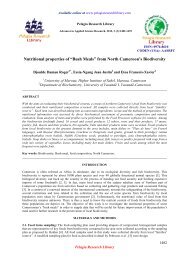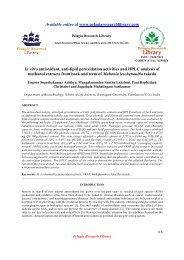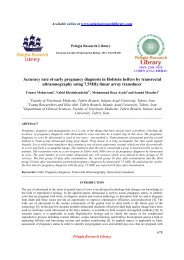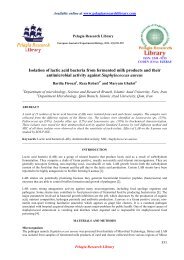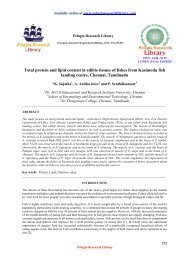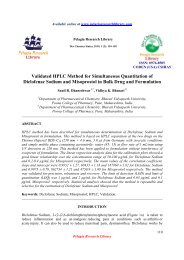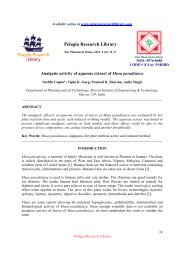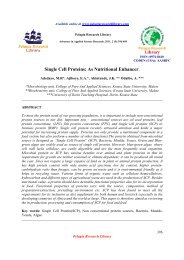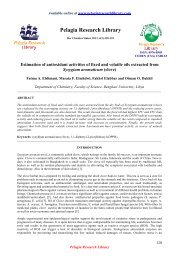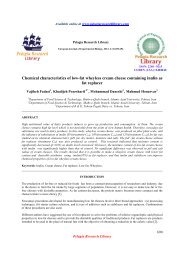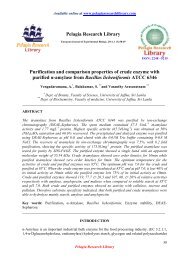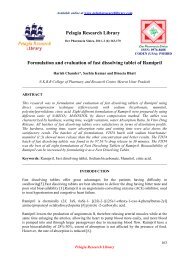Polymorphism of IGF-1 gene in Makoei Sheep using PCR-SSCP
Polymorphism of IGF-1 gene in Makoei Sheep using PCR-SSCP
Polymorphism of IGF-1 gene in Makoei Sheep using PCR-SSCP
Create successful ePaper yourself
Turn your PDF publications into a flip-book with our unique Google optimized e-Paper software.
Available onl<strong>in</strong>e at www.pelagiaresearchlibrary.com<br />
Pelagia Research Library<br />
European Journal <strong>of</strong> Experimental Biology, 2013, 3(2):490-494<br />
<strong>Polymorphism</strong> <strong>of</strong> <strong>IGF</strong>-1 <strong>gene</strong> <strong>in</strong> <strong>Makoei</strong> <strong>Sheep</strong> us<strong>in</strong>g <strong>PCR</strong>-<strong>SSCP</strong><br />
Cobra Moradian 1 , Giti esmailnia 1 and Abbas Hajihosse<strong>in</strong>lo 2*<br />
ISSN: 2248 –9215<br />
CODEN (USA): EJEBAU<br />
1 Department <strong>of</strong> Biology, Science and Research Branch, Islamic Azad University, Tehran, Iran<br />
2 Department <strong>of</strong> Animal Science, Faculty <strong>of</strong> Agriculture, Urmia University, Urmia, Iran<br />
_____________________________________________________________________________________________<br />
ABSTRACT<br />
The native breeds, because <strong>of</strong> their natural selection aga<strong>in</strong>st harsh environment and adaptation to regional<br />
conditions are important to resource-poor farmers and pastoralists. The <strong>IGF</strong>1 <strong>gene</strong> (<strong>in</strong>sul<strong>in</strong>-like growth factor 1) is<br />
a candidate <strong>gene</strong> for marker-assisted selection strategies.<strong>IGF</strong>-1 <strong>gene</strong> that has located on chromosome 3 <strong>in</strong> sheep is<br />
a marker for growth rate and meets production and has an important role <strong>in</strong> mammary glands cell differentiation<br />
and proliferation. Genomic DNA was isolated from the blood <strong>of</strong> 100 sheep. Gel monitor<strong>in</strong>g and spectrophotometer<br />
methods were used to determ<strong>in</strong>e the quality and quantity <strong>of</strong> DNA. A 265bp <strong>IGF</strong>-1 exon 1 segment was amplified by<br />
standard <strong>PCR</strong>, us<strong>in</strong>g the locus specific primers. Polymerase cha<strong>in</strong> reaction-s<strong>in</strong>gle strand conformation<br />
polymorphism (<strong>PCR</strong>-<strong>SSCP</strong>) analysis <strong>of</strong> the 5’ flank<strong>in</strong>g region (Exon1) <strong>of</strong> the ov<strong>in</strong>e <strong>IGF</strong>-I <strong>gene</strong> revealed three<br />
band<strong>in</strong>g patterns (genotypes) named as A/A, A/G and G/G. The frequencies <strong>of</strong> the observed genotypes were<br />
0/52,0/42,0/06, respectively. Allele frequencies were 0/73,0/27 for A,G. The most frequent allele and genotype <strong>in</strong> the<br />
'<strong>Makoei</strong>' sheep breed were 0/73 and 0/52 for allele A and genotype AA, respectively. Observed heterozygosity<br />
(Hobs) value was 0/3942. The observed distribution <strong>of</strong> genotypes was not different than the distribution expected<br />
under the assumption <strong>of</strong> Hardy-We<strong>in</strong>berg equilibrium. These results confirmed the potential usefulness <strong>of</strong> <strong>IGF</strong>-1<br />
<strong>gene</strong> <strong>in</strong> marker-assisted selection programs for sheep breed<strong>in</strong>g.<br />
Key words: <strong>IGF</strong>-1 <strong>gene</strong>, polymerase cha<strong>in</strong> reaction (<strong>PCR</strong>), s<strong>in</strong>gle strand conformation polymorphism technique<br />
(<strong>SSCP</strong>), <strong>Makoei</strong> <strong>Sheep</strong><br />
_____________________________________________________________________________________________<br />
INTRODUCTION<br />
<strong>Makoei</strong> is a breed <strong>of</strong> sheep classified as fat-tailed, similar to Turkish White Karaman and represents an important<br />
multi-purpose sheep for production <strong>in</strong> the East and West Azerbaijan prov<strong>in</strong>ces <strong>of</strong> Iran. There are more than 35<br />
million sheep <strong>in</strong> this region <strong>of</strong> which 5 million is reported to be <strong>Makoei</strong> breed. They are multi colored: black, white<br />
with black spots on face and feet. A live female sheep weight about 47 kg. Birth weight <strong>of</strong> the lambs is 3.7–3.5<br />
(male/females) kg. Maximum milk yield per lactation is 100 kg. (6%fat) and maximum <strong>of</strong> yearly fleece weight<br />
reaches to 3 kg per sheep [1]. Indigenous <strong>gene</strong>tic resources <strong>of</strong> the world are at the risk <strong>of</strong> ext<strong>in</strong>ction due to absorbent<br />
cross<strong>in</strong>g with commercial breeds [2].Even though mature <strong>IGF</strong>-I is a relatively small peptide, its <strong>gene</strong> is surpris<strong>in</strong>gly<br />
large <strong>in</strong> mammals, compris<strong>in</strong>g 80 to 100 kb <strong>of</strong> genomic DNA [3-4]. In humans, pigs, goats, rats, and chickens, the<br />
<strong>IGF</strong>1 nucleotide sequence is about 70-90 kb [4-5]. Exon numbers differ between species; for example, goats, pigs<br />
and sheep have 1-6 exons [6]and humans and rats 1-5 [3-4]. The <strong>IGF</strong>-1 <strong>gene</strong> that is located on chromosome 3 <strong>in</strong><br />
sheep is a marker for growth rate and meat production and has an important role <strong>in</strong> mammary gland cell<br />
differentiation and prolife ratio [7]. The <strong>IGF</strong> family is made up <strong>of</strong> the follow<strong>in</strong>g three related ligands: <strong>in</strong>sul<strong>in</strong>, <strong>IGF</strong>-I,<br />
and <strong>IGF</strong>-II. Both <strong>IGF</strong>I and II are found <strong>in</strong> circulation and extracellular fluids conjugated to any one <strong>of</strong> six different<br />
<strong>IGF</strong> b<strong>in</strong>d<strong>in</strong>g prote<strong>in</strong>s (<strong>IGF</strong>BP) [8]. Insul<strong>in</strong>-like growth factors one and two (somatomed<strong>in</strong>s- <strong>IGF</strong>-I and <strong>IGF</strong>-2) are<br />
structurally related prote<strong>in</strong>s that have a key role <strong>in</strong> cell differentiation, embryo<strong>gene</strong>sis, growth and regulation <strong>of</strong><br />
Pelagia Research Library<br />
094
A. Hajihosse<strong>in</strong>lo et al Euro. J. Exp. Bio., 2013, 3(2):490-494<br />
_____________________________________________________________________________<br />
metabolism [9]. <strong>IGF</strong>1 is a mediator <strong>of</strong> many biological effects; for example, it <strong>in</strong>creases the absorption <strong>of</strong> glucose,<br />
stimulates myo<strong>gene</strong>sis, <strong>in</strong>hibits apoptosis, participates <strong>in</strong> the activation <strong>of</strong> cell cycle <strong>gene</strong>s, <strong>in</strong>creases the synthesis <strong>of</strong><br />
lipids, stimulates the production <strong>of</strong> progesterone <strong>in</strong> granular cells, and <strong>in</strong>tervenes <strong>in</strong> the synthesis <strong>of</strong> DNA, prote<strong>in</strong>,<br />
RNA , and <strong>in</strong> cell proliferation [10]. <strong>IGF</strong>-I has been reported to be necessary for progression <strong>of</strong> cells through both<br />
the G1 and the G2/M phases <strong>of</strong> the cell cycle [11].<br />
<strong>Polymorphism</strong> <strong>in</strong> exon I <strong>of</strong> ov<strong>in</strong>e <strong>IGF</strong>-1 <strong>gene</strong> identified us<strong>in</strong>g s<strong>in</strong>gle-strand conformational polymorphism analysis<br />
and revealed that two allelic variant <strong>in</strong> a 265bp <strong>in</strong> mixed and Baluchi sheep breeds[12-13]. The objective <strong>of</strong> this<br />
study was to characterize potential variation at the ov<strong>in</strong>e <strong>IGF</strong>-1 <strong>gene</strong> <strong>in</strong> '<strong>Makoei</strong>' sheep breeds us<strong>in</strong>g polymerase<br />
cha<strong>in</strong> reaction and s<strong>in</strong>gle-strand conformational polymorphism (<strong>PCR</strong>–<strong>SSCP</strong>) analysis.<br />
MATERIALS AND METHODS<br />
<strong>Sheep</strong>, blood sample collection and genomic DNA extraction<br />
The <strong>Makoei</strong> breed <strong>of</strong> sheep were exam<strong>in</strong>ed <strong>in</strong> this study, they are fat-tailed sheep with medium body size, white <strong>in</strong><br />
color with black spots on face and feet. They are farmed <strong>in</strong> the east and west Azerbaijan prov<strong>in</strong>ces <strong>of</strong> Iran for meat<br />
and wool[14].Blood samples were collected <strong>in</strong>to a 5 ml EDTA vacuta<strong>in</strong>er tube and transferred to the laboratory<br />
with<strong>in</strong> 2 hours for DNA extraction. Total DNA extractions were made with a modified salt<strong>in</strong>g out method [15]from<br />
whole fresh blood. Quality and quantity <strong>of</strong> extracted DNA was measured on 0.8% agaroze gel prepared <strong>in</strong> 0.5× TBE<br />
buffer (45 Mm Tris base, 45 Mm boric acid, 1mM EDTA pH 8.0) and visualized with ethidium bromide (1.0 μgml-<br />
1) and photographed under UV light.<br />
Amplification <strong>of</strong> the exon 1 <strong>of</strong> <strong>IGF</strong>-1 <strong>gene</strong><br />
Two polymerase cha<strong>in</strong> reaction (<strong>PCR</strong>) primers, <strong>IGF</strong>-1-up (5′-ATTACAG CTGCCTGCCCCTT-3′ ) and <strong>IGF</strong>-1-<br />
down( 5'-CACATCTGCTAATACACCTTACCCG-3') target<strong>in</strong>g a fragment <strong>of</strong> 265bp were employed <strong>in</strong> DNA<br />
amplifications as described by Yilmaz et al.,[12].that Based on the sequence <strong>of</strong> the ov<strong>in</strong>e <strong>IGF</strong>-I <strong>gene</strong> from Dickson<br />
et al.,[16](1991).<strong>PCR</strong> conta<strong>in</strong>ed 25-50 ng genomic DNA, 10 pmoL <strong>of</strong> each primer, 2 μL 10X <strong>PCR</strong> buffer, 1.5 mM<br />
MgCl2, 200 μMdNTP and 1 unit Taq-polymerase, <strong>in</strong> a total volume <strong>of</strong> 20 μL . DNA amplifications were performed<br />
us<strong>in</strong>g Master cycler (Eppendorf, Germany) programmed for a prelim<strong>in</strong>ary step <strong>of</strong> 2 m<strong>in</strong> at 95°C, followed by<br />
31cycles <strong>of</strong> 45 s at94°C, 30 s at 58°C and 30 s at 72°C, with a f<strong>in</strong>al extension <strong>of</strong> 3m<strong>in</strong>at 72°C. Amplification was<br />
verified by electrophoresis on 1.5% (w/v) agarose gel <strong>in</strong> 1 x TBE buffer (2 mM <strong>of</strong> EDTA, 90 mM <strong>of</strong> Tris-Borate,<br />
pH 8.3), us<strong>in</strong>g a 100bp ladder as a molecular weight marker for confirmation <strong>of</strong> the length <strong>of</strong> the <strong>PCR</strong> products.<br />
Gels were sta<strong>in</strong>ed with ethidium bromide (1 μg/mL).<br />
S<strong>in</strong>gle strand confirmation polymorphism (<strong>SSCP</strong>)<br />
<strong>PCR</strong> products were mixed with 8 μl <strong>of</strong> denatur<strong>in</strong>g load<strong>in</strong>g dye (95% (w/v) deionized formamide, 0.05% (w/v)<br />
xylene cyanol, 0.05% (w/v) bromophenol blue and 0.02M EDTA) <strong>in</strong> a total volume <strong>of</strong> 15 μl. The mixture was<br />
denatured at 95°C for 5 m<strong>in</strong> and was snap chilled on ice. The total volume was run <strong>in</strong> a 15% polyacrylamide gel, as<br />
described by Herr<strong>in</strong>g et al.<br />
The electrophoresis was performed <strong>in</strong> 0.5 × TBE buffer (Tris 100 mM, boric acid 9 mM, EDTA 1mM) at room<br />
temperature (18°C) and constant 200 V for 3 h. Polyacrylamide gels were sta<strong>in</strong>ed with silver accord<strong>in</strong>g to the<br />
protocol described by Herr<strong>in</strong>g et al.<br />
Statistical analysis<br />
The allelic and genotypic frequencies, observed and expected Nei’sheterozygosities (HE=1-Σpi2, where Pi is the<br />
frequency <strong>of</strong> allele i) were estimated us<strong>in</strong>g Pop Gene32 program (ver 1.31, Canada)[17]Hardy-We<strong>in</strong>berg<br />
equilibrium.<br />
RESULTS<br />
The amplification <strong>of</strong> a 265bp fragment <strong>of</strong> the <strong>IGF</strong>-1 exon 1 <strong>gene</strong> was successful <strong>in</strong> our first attempt. All extracted<br />
DNAs from rams blood samples yielded a specific s<strong>in</strong>gle band <strong>PCR</strong> product without any nonspecific band (Figure<br />
1).<br />
Pelagia Research Library<br />
094
A. Hajihosse<strong>in</strong>lo et al Euro. J. Exp. Bio., 2013, 3(2):490-494<br />
_____________________________________________________________________________<br />
Figure 1. <strong>PCR</strong> products analyzed by Electrophoresis <strong>in</strong> a 1.5% agarose gel with ethidium bromide sta<strong>in</strong><strong>in</strong>g<br />
Therefore, the <strong>PCR</strong> products were directly used for <strong>SSCP</strong> analysis. The allelic variation <strong>in</strong> the <strong>IGF</strong>-1 <strong>gene</strong> was<br />
exam<strong>in</strong>ed by <strong>PCR</strong>-<strong>SSCP</strong>. The non-denatur<strong>in</strong>g gel electrophoresis enabled visualization <strong>of</strong> s<strong>in</strong>gle-stranded DNA<br />
(ssDNA) and <strong>SSCP</strong> band patterns. In this study, a total <strong>of</strong> three <strong>SSCP</strong> patterns were observed <strong>in</strong> the exam<strong>in</strong>ed sheep<br />
(Figure 2).<br />
Figure 2.<strong>SSCP</strong> polymorphism <strong>of</strong> '<strong>Makoei</strong>' sheep <strong>IGF</strong>-1<strong>gene</strong>. Three different <strong>PCR</strong>-<strong>SSCP</strong> patterns (genotype) were identified.<br />
The frequencies <strong>of</strong> the observed genotypes were 0/52,0/42,0/06, respectively. Allele frequencies were 0/73,0/27 for<br />
A,G. Observed heterozygosity (Hobs) value was 0.3942 (table 1).<br />
Table 1.Observed allele and genotypic frequencies for <strong>IGF</strong>-1 locus <strong>in</strong> '<strong>Makoei</strong>' sheep<br />
Allele frequency<br />
A G<br />
0.73 0.23<br />
Frequency genotypic<br />
AA AG GG<br />
0.52 0.42 0.06<br />
The observed distribution <strong>of</strong> genotypes was not different than the distribution expected under the assumption <strong>of</strong><br />
Hardy-We<strong>in</strong>berg equilibrium. The expected homozigosity (Homexp) value for <strong>IGF</strong>-1 was 0.6018, expected<br />
heterozygosity (Hexp) was 0.3982 and average heterozygosity was 0.3942 (Table 2).<br />
Table 2.Summary <strong>of</strong> heterozygosity statistics for all loci<br />
Locus<br />
<strong>IGF</strong>-1<br />
ObsHom<br />
0.58<br />
ObsHet<br />
0.42<br />
ExpHom<br />
0.6018<br />
ExpHet<br />
0.3982<br />
Nei<br />
0.3942<br />
AveHet<br />
0.3942<br />
Effective number <strong>of</strong> alleles was 1.65 and Shannon's Information <strong>in</strong>dex (I) was 0.58 (Table 3).<br />
Table 3.Summary <strong>of</strong> <strong>gene</strong>tic variation statistics for all loci.<br />
Locus Na ne I<br />
<strong>IGF</strong>-1 2 1.65 0.58<br />
na = observed number <strong>of</strong> alleles; ne = Effective number <strong>of</strong> alleles (Kimura and Crow, 1964); I =Shannon's Information <strong>in</strong>dex (Lewont<strong>in</strong>, 1972)<br />
DISCUSSION<br />
The <strong>PCR</strong>-<strong>SSCP</strong> method A simple and quick method was developed to score the marker genotype, which will reduce<br />
the time and cost <strong>of</strong> typ<strong>in</strong>g the marker genotype by approximately three-fourths. This method <strong>of</strong> scor<strong>in</strong>g the marker<br />
Pelagia Research Library<br />
094
A. Hajihosse<strong>in</strong>lo et al Euro. J. Exp. Bio., 2013, 3(2):490-494<br />
_____________________________________________________________________________<br />
genotype can be applied to selection <strong>of</strong> sheep if the marker is proven to be associated with performance traits <strong>in</strong><br />
sheep. In other words, this marker can affect phenotypic traits or be <strong>in</strong> disequilibrium l<strong>in</strong>kage with polymorphisms<br />
affect<strong>in</strong>g traits [18]. In earlier studies <strong>of</strong> a d<strong>in</strong>ucleotide repeat polymorphism <strong>in</strong> the 5 flank<strong>in</strong>g region <strong>of</strong> the <strong>IGF</strong>-I<br />
<strong>gene</strong> <strong>in</strong> cattle and sw<strong>in</strong>e, a possible role <strong>of</strong> this somatomediater <strong>in</strong> production traits was evident [19]. There have<br />
been studies <strong>of</strong> the allelic frequency <strong>of</strong> <strong>IGF</strong>-I <strong>gene</strong> <strong>in</strong> different cattle breeds, and beef cattle is considered to be a<br />
model for this system [18, 20, 21]. In Angus cattle, these primers produced a frequency <strong>of</strong> 0.64 for the A allele and<br />
0.36 for the B allele [18]. The role <strong>of</strong> <strong>IGF</strong>-I and its b<strong>in</strong>d<strong>in</strong>g prote<strong>in</strong>s has been reviewed [22-23] <strong>IGF</strong>-I mediate cell<br />
proliferation and is essential for normal development <strong>of</strong> the mammary gland dur<strong>in</strong>g puberty and pregnancy [24].<br />
Most studies <strong>of</strong> beef cattle have revealed an association between <strong>gene</strong> polymorphism and body condition scor<strong>in</strong>g<br />
and weight, particularly <strong>in</strong> early life stages. This <strong>gene</strong> <strong>in</strong> different breeds may affect different characteristics <strong>in</strong> the<br />
same species, depend<strong>in</strong>g on the selection program.<br />
In the present study were f<strong>in</strong>d out a SNP (s<strong>in</strong>gle nucleotide polymorphism), <strong>in</strong> the 5’ flank<strong>in</strong>g region <strong>of</strong> the ov<strong>in</strong>e<br />
<strong>IGF</strong>-I <strong>gene</strong> <strong>in</strong> <strong>Makoei</strong> sheep. For a fragment <strong>of</strong> 265bp <strong>in</strong> the 5’ flank<strong>in</strong>g region <strong>of</strong> the ov<strong>in</strong>e <strong>IGF</strong>-I <strong>gene</strong>, 467 to<br />
732bp upstream from the 5’ end <strong>of</strong> Exon1, three conformational patterns were observed. Found the same patterns<br />
that corresponded with the three genotypes A/A, A/B, and B/B <strong>in</strong> mixed breed sheep. In this study, variation <strong>in</strong> the<br />
exon I sequence <strong>of</strong> the sheep ov<strong>in</strong>e <strong>IGF</strong>-1 <strong>gene</strong> was <strong>in</strong>vestigated by polymerase cha<strong>in</strong> reaction–s<strong>in</strong>gle strand<br />
conformational polymorphism (<strong>PCR</strong>–<strong>SSCP</strong>) analysis. Two alleles (A, B) and three genotypes (AA, AG, GG) were<br />
observed <strong>in</strong> <strong>IGF</strong>-1 exon 1<strong>gene</strong> <strong>of</strong> '<strong>Makoei</strong>' sheep. The most frequent allele and genotype <strong>in</strong> the '<strong>Makoei</strong>' sheep breed<br />
were 0/73and 0/52 for allele A and genotype AA, respectively. Results <strong>of</strong> this study partly are <strong>in</strong> accordance with<br />
the results Previous researches that two allele observed <strong>in</strong> three mixed-breed and Baluchi and '<strong>Makoei</strong>'sheep breeds.<br />
This study may be regarded as the beg<strong>in</strong>n<strong>in</strong>g <strong>of</strong> attempts to understand the <strong>gene</strong>tic variability <strong>of</strong> native sheep breeds<br />
<strong>in</strong> the Azerbaijan region. This study confirmed the importance <strong>of</strong> molecular studies beside the morphological data <strong>in</strong><br />
detect<strong>in</strong>g <strong>gene</strong>tic variation among <strong>in</strong>dividuals <strong>in</strong> select<strong>in</strong>g diverse parents to construct<strong>in</strong>g a new population<br />
successfully. Further studies are necessary to determ<strong>in</strong>e whether the polymorphisms <strong>in</strong> these cod<strong>in</strong>g regions are<br />
<strong>in</strong>tr<strong>in</strong>sically related to the quantitative traits, such as body weight, daily weight ga<strong>in</strong> and growth trait.<br />
Acknowledgments<br />
We are grateful to the head <strong>of</strong> the Institute <strong>of</strong> Biotechnology, Urmia University for provid<strong>in</strong>g laboratory facilities<br />
and the directors <strong>of</strong> Research centers <strong>of</strong> <strong>Makoei</strong> sheep breed<strong>in</strong>g for provid<strong>in</strong>g animals. This work was k<strong>in</strong>dly granted<br />
by Vice Chancellor <strong>in</strong> Research <strong>of</strong> Urmia University, Urmia, Iran.<br />
REFERENCES<br />
[1] Annual report <strong>of</strong> the Department <strong>of</strong> Agriculture <strong>of</strong> Western Aazerbayjan, Iran (2001).<br />
[2] FAO. Report on the International Technical Conference on Animal Genetic Resources for Food and Agriculture,<br />
Interlaken Switzerland, September, 2007.<br />
[3] Rotwe<strong>in</strong> P, Pollock KM, Didier DK and Krivi GG. J. Biol. Chem, 1986, 261, 4828-4832.<br />
[4] Shimatsu A, Rotwe<strong>in</strong> P. J. Biol. Chem,1987, 262, 7894-7900.<br />
[5] Kajimoto Y and Rotwe<strong>in</strong> P. J. Biol. Chem, 1991, 266, 9724-9731.<br />
[6] Mikawa S, Yoshikawa G, Aoki H, Yamano Y, et al. Biosci. Biotechnol.Biochem, 1995, 59, 87-92.<br />
[7] Imam-Ghali MI, Saidi-Mehtar N, Guer<strong>in</strong> G. Animal Genetics, 1991, 22,165.<br />
[8] Clemmons, D. R. Cytok<strong>in</strong>e Growth Factor Rev, 1999; 8, 45–62.<br />
[9] Siadkowska E, Zwierzchowski L, Oprzadek J and Strzalkowska N. Anim. Sci. Pap. Rep, 2006, 3, 225-237.<br />
[10] Etherton TD. J. Anim. Sci, 2004; 82 (E-Suppl): E239-E244.<br />
[11] Adesanya, O.O, Zhou J, Samathanam C, Powell-Braxton L, and Bondy C. A. Proc. Natl. Acad. Sci,1999; 96,<br />
3287–3291.<br />
[12] Yilmaz A, Davis ME. J Appl Genet, 2005, 46, 3, 307-309.<br />
[13] Tahmoorespur M, VafayeValeh M, Nassiry M. R, Moussavi A. Heravi, Ansary M. S Afr J Anim Sci. 2009, 39,<br />
97–101.<br />
[14] Saadat-Noori M, Siah-Mansoor S. <strong>Sheep</strong> Husbandary and Management. Tehran: Ashrafi Publication, 1992.<br />
[15] Miller SA, Dykes DD,Polesky HF. Nucleic Acids Res, 1998, 16, 1215.<br />
[16] Dickson MC, Saunders JC, Gilmour RS. J. Mol. Endocr<strong>in</strong>ol, 1991, 6,17–31.<br />
[17] Yeh FC, Yang R ,Boyle T . POPGENE. Version 1.31.University <strong>of</strong> Alberta, 1999, Edmonton Canada<br />
[18] Ge W, Davis ME, H<strong>in</strong>es HC. J. Anim. Genet ,1997, 28, 155-156.<br />
[19] Kirkpatrick BW. Anim. Genet, 1992, 23, 543-548.<br />
[20] Spicer LJ, Chase CC Jr and Rutter LM. J. Anim. Sci, 2002, 80, 716-722.<br />
[21] Curi RA, Oliveira HN, SilveiraAC , Lopes CR. Anim. Genet, 2005, 36, 58-62.<br />
[22] Sara VR and Hall K. Physiol. Rev, 1990, 70, 591-614.<br />
[23] Jones JI and Clemmons DR. Endocr. Rev, 1995, 16, 3-34.<br />
Pelagia Research Library<br />
094
A. Hajihosse<strong>in</strong>lo et al Euro. J. Exp. Bio., 2013, 3(2):490-494<br />
_____________________________________________________________________________<br />
[24] Marshman E and Streuli CH. Breast Cancer Res, 2002, 4, 231-239.<br />
Pelagia Research Library<br />
090



